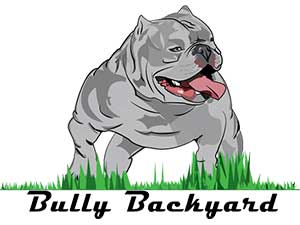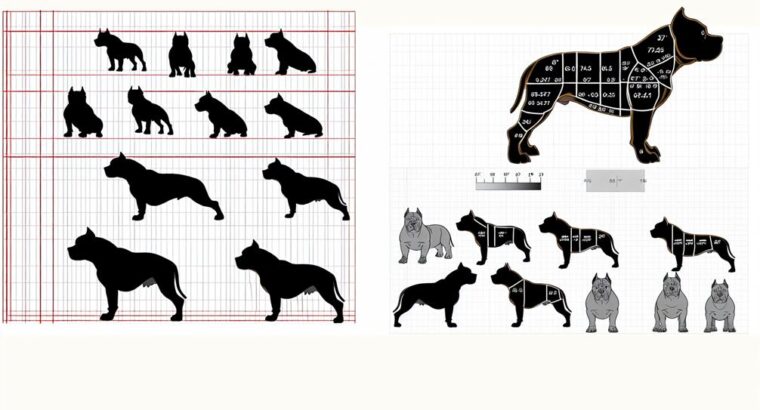American Bully Size Chart
The American Bully Size Chart serves as a valuable tool for owners and breeders alike, offering a structured approach to understanding the diverse range of sizes within this breed.
From the compact Pocket Bully to the robust XL, each category presents unique considerations for their care and management.
However, the significance of this chart extends beyond mere measurements; it opens a gateway to comprehending the intricacies of growth patterns, health implications, and the interplay between size and well-being in American Bullies.
Understanding how these factors intersect is pivotal in optimizing the quality of life for these beloved canine companions.
American Bully Size Categories
American Bully size categories encompass a range of classifications, including Pocket, Standard, Classic, XL, and Extreme variations. Each category is defined by specific height and weight ranges, with Pocket American Bullies being the smallest and Extreme American Bullies the largest.
Understanding these size categories is essential for providing appropriate care and tracking the growth of American Bullies.
Pocket American Bullies typically stand between 14 to 17 inches at the withers and weigh around 17 to 20 inches. In contrast, Extreme American Bullies can reach heights of up to 20 inches or more and weigh over 100 pounds. Standard American Bullies fall between these two extremes, with Classic and XL variations offering intermediate size options.
Measuring American Bullys Height
When determining the height of a Bully breed, positioning the dog upright and utilizing a soft measuring tape at the withers is essential for accuracy. This measuring technique is critical in tracking the growth of American Bullys effectively.
Height measurement is a key factor in categorizing American Bullys into different size categories, namely Pocket, Standard, Classic, and XL. The maximum height for a Pocket American Bully is 17 inches, while XL Bullys can reach heights of 20-23 inches.
Consistent and proper measuring methods not only help in determining the size category but also guarantee uniformity in tracking the development of the Bully breed. By focusing on the withers, which are the highest point on the dog's shoulder blades, one can obtain a reliable height measurement. This attention to detail aids in accurately placing American Bullys into their respective size classifications based on their height.
Average Neck Size Measurement
How does the average neck size of an American Bully compare to other dog breeds?
The average neck size for an American Bully typically ranges from 14 to 18 inches in circumference. When measuring the neck size for your American Bully, it is important to measure at the base of the neck to make accurate fitting of collars.
It's essential to note that the neck size can vary among individual American Bullys based on their build and weight.
Selecting the correct collar size is critical for your dog's comfort and safety. A collar that is too loose may slip off, while one that is too tight can be uncomfortable or even pose a safety risk.
Regularly measuring your American Bully's neck size and adjusting the collar accordingly as they grow is key to making a proper fit and maintaining their comfort and safety.
Accurate Weight Measurement
For a thorough evaluation of an American Bully's health and well-being, precise weight measurement plays an essential role. Using a reliable scale on a flat surface is critical for accurately determining the Bully's weight. It is also important to take the body condition score when measuring weight to get a more complete assessment of the Bully's health status.
Regularly monitoring weight changes is key to ensuring that your American Bully falls within the healthy range. Adjusting the diet and exercise regimen based on weight measurements is necessary to maintain the best health for your pet. If size concerns arise or if you are unsure about your Bully's weight, consulting a veterinarian for guidance is recommended.
Veterinarians can provide expert advice on weight management strategies tailored to your American Bully's specific needs, ensuring that they remain healthy and happy.
Identifying Underweight or Overweight
An important aspect in maintaining the best health of an American Bully is the accurate identification of whether the dog is underweight or overweight. Monitoring signs of underweight, such as visible ribs or spine, is critical. In such cases, adjustments to the diet and exercise regimen are necessary to help the American Bully reach a healthy weight.
On the other hand, signs of overweight, like difficulty feeling ribs or excessive fat, indicate the need for diet modifications. Consulting a size chart can assist in determining the ideal weight range for an American Bully.
To address underweight issues, feeding portions should be adjusted, and exercise should be increased. It is essential to ensure proper portion control and consider weight management training to maintain a healthy weight in American Bullies.
Growth Completion Age
The culmination of growth in American Bullies typically occurs between the ages of 12 to 18 months, marked by the completion of bone and muscle development. During this period, bones and muscles continue to develop, with the process often extending until the Bully reaches around 2 years of age. Monitoring the growth completion age is vital for evaluating the overall size and health of the dog.
Various factors such as genetics, nutrition, and exercise play significant roles in influencing the timing of growth completion in American Bullies. Understanding when growth typically stops is essential as it aids in predicting the dog's final size and weight accurately. By keeping a close eye on the development of bones and muscles during this 12-18 month period, owners can make sure that their American Bully grows to its full potential in a healthy manner.
Growth Stages From Puppy to Adult
Upon reaching their maximum height at around 10 months, American Bully puppies begin a series of growth stages leading into adulthood, marked by the hardening of growth plates by 18 months.
During this change, it is essential to switch their diet from puppy food to adult food around the 10-month mark to make certain they receive the necessary nutrients for proper growth. Additionally, establishing regular exercise routines is vital to promote muscle development and overall health in American Bully puppies as they mature.
Monitoring their padding out, weight fluctuations, and hormonal balance is also key during this period to make sure they are growing at a healthy rate.
Factors Influencing Size
Genetics greatly influence the size of an American Bully, shaping its physical characteristics as it grows from puppyhood to adulthood. Nutrition during puppyhood plays an essential role in the final size of the dog. Providing a balanced diet with appropriate nutrients is important for healthy growth and development. Additionally, proper exercise and physical activity are key factors in ensuring a well-proportioned and healthy size. Regular vet checkups are important for monitoring growth and detecting any potential issues that may affect the dog's size.
Understanding the breed standards and size variations within the American Bully breed can also help in predicting the final size of the dog. By familiarizing oneself with the expected size range based on the breed standard, owners can better prepare for the potential size of their American Bully. Monitoring growth patterns and ensuring that the dog maintains a healthy size development through a combination of proper nutrition, exercise, and vet care is essential for the overall well-being of the American Bully.
Health Impacts on Growth
Influencing the growth of American Bullies, health factors such as hip dysplasia and nutrition deficiencies can greatly impact the development and size of the breed. Health issues like hip dysplasia and thyroid problems can disrupt the normal growth rate of American Bullies, potentially leading to stunted growth or other complications.
Similarly, nutrition deficiencies can hinder the proper development of American Bully puppies, affecting their size and overall health. Regular vet checkups are essential to monitor the health and growth of American Bullies, enabling early detection of any issues that could impede their best growth trajectory.
Ensuring proper nutrition, exercise, and healthcare is vital for the healthy growth of American Bullies, promoting their overall well-being and size. By addressing these health factors proactively, owners can support the best possible growth and development outcomes for their American Bully companions.
Managing American Bullys Weight
Monitoring and managing the weight of American Bullies is essential for their overall health and well-being. Regular monitoring of American Bully weight is vital to prevent health issues such as obesity or malnourishment. Consulting a vet for guidance on managing an American Bully's weight through appropriate diet adjustments and exercise routines is highly recommended. Understanding body condition scoring can help determine if an American Bully is underweight, overweight, or at an ideal weight.
Gradually increasing food portions and incorporating supplements can safely help in fattening up an underweight American Bully.
To maintain a healthy weight, it is important to establish a consistent feeding schedule, practice portion control, and engage in regular exercise activities. By implementing these strategies, you can help prevent your American Bully from experiencing weight-related health problems. Regular veterinary check-ups and consultations can provide further insight into managing your Bully's weight effectively.
Conclusion
To sum up, the American Bully Size Chart provides valuable information for owners to comprehend the various size categories, measuring techniques, growth stages, and health considerations essential for the well-being of these dogs.
By following the guidelines outlined in the chart, owners can guarantee their American Bully maintains a healthy weight and size throughout its life, promoting a happy and thriving companion.

